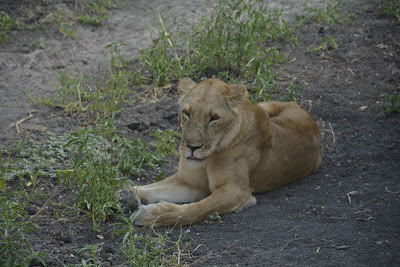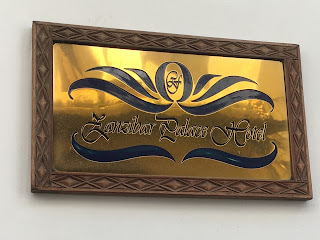 |
| Stone Town Market |
After the Slave Trade museum and church we headed to the open air market. The market is massive with everything from meat and chicken to fish and lots of vegetables and spices. The smell of the place was a combination of the best spices and scents of fresh produce to the harsh smell of unrefrigerated meat and poultry with a lot of hard working human sweat thrown into the mix. In a few dozen steps you could go from loving food to never wanting to eat animal produce again. To think that this market has been here for well over 500 years is amazing.
 |
| Our guide Awesu Ismail with the horns. |
 |
| Yummy, Yummy Octopus. |
 |
| Peppers a plenty. |
After the market and street tour, we headed back to lunch at an outdoor café near Freddie Mercury's house with very good grilled octopus and chips. We then went back to the hotel for a nap.
Dinner at the Zanzibar Palace Hotel was called Swahili Experience with dishes of rice and beans and peas accompanied by skewers of beef and chicken. It was a very nice meal.
The next day Awesu took us out to a spice farm where they grow everything from the famous Zanzibar cloves, lemon grass, cinnamon, ginger, and many kinds of pepper corns.
Interesting fact about pepper corns, the black and white and red pepper corns are from the same plant, just picked at different times of ripeness.
 |
| Awesu's assistant demonstrates how to use fruit as a lip stick or hair color. |
After the spice tour, we headed back to town to get ready for the evening. The whole island was celebrating a holiday known as Eid al-Adha.
Eid al-Adha is an Islamic festival to commemorate the willingness of Ibrahim (also known as Abraham) to follow Allah's (God's) command to sacrifice his son Ishmael. Muslims around the world observe this event. Everyone was dressed up in their best clothes and even the really little kids had on their bright new outfits. The place was packed starting at sunset and stopped around 11pm. We had dinner at an Indian Restaurant named The Silk Route just to the left of the tunnel after you leave the waterfront park. The food was terrific and after many courses, we pushed our way home to the hotel for our last night on the island.
I am going to skip over the 5 hour delay and broken plane with a flat tire fiasco that we endured to get back to the mainland. Sometimes, traveling in small countries can test your mental strength, but we did have beer. Needless to say, we were very happy to get home and sleep in just a little bit the next day at the Upepo Garden Guest House.
 |
| Upepo Garden guest house by the sea. Upepo means "Wind". |
 |
| Had a great breeze all day. |
 |
| Excellent napping area on the beach. |
So now after a dinner with 7 of our party, we head off to bed. Tomorrow we join the "Pride of Africa", Rovos railway train and start our journey south across Africa. We will be out of internet range for around 5 days so stay tuned for our next post.
Cheers,
James and Pat.


















































